
Annual growth cycle of grapevines
Encyclopedia
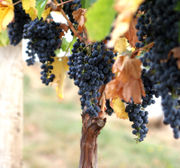
Vitis vinifera
Vitis vinifera is a species of Vitis, native to the Mediterranean region, central Europe, and southwestern Asia, from Morocco and Portugal north to southern Germany and east to northern Iran....
is the process that takes place in the vineyard each year, beginning with bud
Bud
In botany, a bud is an undeveloped or embryonic shoot and normally occurs in the axil of a leaf or at the tip of the stem. Once formed, a bud may remain for some time in a dormant condition, or it may form a shoot immediately. Buds may be specialized to develop flowers or short shoots, or may have...
break in the spring and culminating in leaf fall in autumn followed by winter dormancy
Dormancy
Dormancy is a period in an organism's life cycle when growth, development, and physical activity are temporarily stopped. This minimizes metabolic activity and therefore helps an organism to conserve energy. Dormancy tends to be closely associated with environmental conditions...
. From a winemaking
Winemaking
Winemaking, or vinification, is the production of wine, starting with selection of the grapes or other produce and ending with bottling the finished wine. Although most wine is made from grapes, it may also be made from other fruit or non-toxic plant material...
perspective, each step in the process plays a vital role in the development of grape
Grape
A grape is a non-climacteric fruit, specifically a berry, that grows on the perennial and deciduous woody vines of the genus Vitis. Grapes can be eaten raw or they can be used for making jam, juice, jelly, vinegar, wine, grape seed extracts, raisins, molasses and grape seed oil. Grapes are also...
s with ideal characteristics for making wine
Wine
Wine is an alcoholic beverage, made of fermented fruit juice, usually from grapes. The natural chemical balance of grapes lets them ferment without the addition of sugars, acids, enzymes, or other nutrients. Grape wine is produced by fermenting crushed grapes using various types of yeast. Yeast...
. Viticulturalists and vineyard managers monitor the effect of climate, vine disease and pests in facilitating or impeding the vines progression from bud break, flowering, fruit
Fruit
In broad terms, a fruit is a structure of a plant that contains its seeds.The term has different meanings dependent on context. In non-technical usage, such as food preparation, fruit normally means the fleshy seed-associated structures of certain plants that are sweet and edible in the raw state,...
set, veraison
Veraison
Véraison is a viticulture term meaning "the onset of ripening". It is originally French, but has been adopted into English use...
, harvesting
Harvest (wine)
The harvesting of wine grapes is one of the most crucial steps in the process of winemaking. The time of harvest is determined primarily by the ripeness of the grape as measured by sugar, acid and tannin levels with winemakers basing their decision to pick based on the style of wine they wish to...
, leaf fall and dormancy-reacting if need be with the use of viticultural practices like canopy management, irrigation, vine training and the use of agrochemicals. The stages of the annual growth cycle usually become observable within the first year of a vine's life. The amount of time spent at each stage of the growth cycle depends on a number of factors-most notably the type of climate (warm or cool) and the characteristics of the grape variety.
Bud break
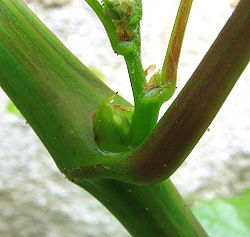
Southern Hemisphere
The Southern Hemisphere is the part of Earth that lies south of the equator. The word hemisphere literally means 'half ball' or "half sphere"...
it begins around September when daily temperatures begin to surpass 10 °C (50 °F). If the vine had been pruned
Pruning
Pruning is a horticultural practice involving the selective removal of parts of a plant, such as branches, buds, or roots. Reasons to prune plants include deadwood removal, shaping , improving or maintaining health, reducing risk from falling branches, preparing nursery specimens for...
during the winter, the start of this cycle is signaled by a "bleeding" of the vine. This bleeding occurs when the soil begins to warm and osmotic forces pushes water, containing a low concentration of organic acid
Organic acid
An organic acid is an organic compound with acidic properties. The most common organic acids are the carboxylic acids, whose acidity is associated with their carboxyl group –COOH. Sulfonic acids, containing the group –SO2OH, are relatively stronger acids. The relative stability of the conjugate...
s, hormones, mineral
Mineral
A mineral is a naturally occurring solid chemical substance formed through biogeochemical processes, having characteristic chemical composition, highly ordered atomic structure, and specific physical properties. By comparison, a rock is an aggregate of minerals and/or mineraloids and does not...
s and sugars, up from the root system
Root system
In mathematics, a root system is a configuration of vectors in a Euclidean space satisfying certain geometrical properties. The concept is fundamental in the theory of Lie groups and Lie algebras...
of the vine and it is expelled from the cuts (or "wounds") left over from pruning the vine. During this period a single vine can "bleed" up to 5 litres (1.3 US gal) of water.
Tiny buds on the vine start to swell and eventually shoot
Shoot
Shoots are new plant growth, they can include stems, flowering stems with flower buds, and leaves. The new growth from seed germination that grows upward is a shoot where leaves will develop...
s begin to grow from the buds. Buds are the small part of the vine that rest between the vine's stem
Plant stem
A stem is one of two main structural axes of a vascular plant. The stem is normally divided into nodes and internodes, the nodes hold buds which grow into one or more leaves, inflorescence , conifer cones, roots, other stems etc. The internodes distance one node from another...
and the petiole
Petiole (botany)
In botany, the petiole is the stalk attaching the leaf blade to the stem. The petiole usually has the same internal structure as the stem. Outgrowths appearing on each side of the petiole are called stipules. Leaves lacking a petiole are called sessile, or clasping when they partly surround the...
(leaf stem). Inside the buds contain usually three primordial
Primordial
Primordial may refer to:* Primordial sea . See abiogenesis* Primordial nuclide, nuclides, a few radioactive, that formed before the Earth existed and are stable enough to still occur on Earth...
shoots. These buds appear in the summer of previous growth cycle green and covered in scales. During winter dormancy they turn brown until the spring when the vine begins the process of bud break and the first sign of green in the vineyard emerges in the form of tiny shoots. The energy to facilitate this growth comes from reserves of carbohydrate
Carbohydrate
A carbohydrate is an organic compound with the empirical formula ; that is, consists only of carbon, hydrogen, and oxygen, with a hydrogen:oxygen atom ratio of 2:1 . However, there are exceptions to this. One common example would be deoxyribose, a component of DNA, which has the empirical...
stored in roots and wood of the vine from the last growth cycle. Eventually the shoots sprout tiny leaves that can begin the process of photosynthesis
Photosynthesis
Photosynthesis is a chemical process that converts carbon dioxide into organic compounds, especially sugars, using the energy from sunlight. Photosynthesis occurs in plants, algae, and many species of bacteria, but not in archaea. Photosynthetic organisms are called photoautotrophs, since they can...
, producing the energy to accelerate growth. In warm climates, after about 4 weeks the growth of the shoots starts to rapidly accelerate with the shoots growing in length an average of 3 cm (1 in) a day.
In temperate climates, where temperatures can reach above 10 °C (50 °F) in mid-winter, some early budding varieties (such as Chardonnay
Chardonnay
Chardonnay is a green-skinned grape variety used to make white wine. It is originated from the Burgundy wine region of eastern France but is now grown wherever wine is produced, from England to New Zealand...
) can be at risk of premature bud break. This is a potential viticultural hazard in places like the Margaret River
Margaret River
Margaret River is a river in southwest Western Australia. Although small and unremarkable, it is the eponym of the iconic town and tourist region of Margaret River, famous for its surfing, caves and wine....
region of Western Australia where warm currents from the Indian Ocean can coax Chardonnay vines to prematurely bud in the mid-winter month of July. After bud break, the young shoots are very vulnerable to frost
Frost
Frost is the solid deposition of water vapor from saturated air. It is formed when solid surfaces are cooled to below the dew point of the adjacent air as well as below the freezing point of water. Frost crystals' size differ depending on time and water vapour available. Frost is also usually...
damage with vineyard managers going to great lengths protect the fragile shoots should temperature dramatically drop below freezing. This can include setting up heaters or wind circulators in the vineyard to keep cold air from settling on the vines.
Flowering
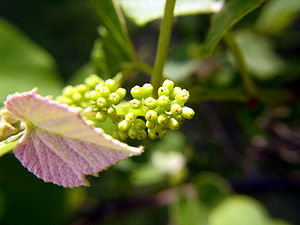

Pollination
Pollination is the process by which pollen is transferred in plants, thereby enabling fertilisation and sexual reproduction. Pollen grains transport the male gametes to where the female gamete are contained within the carpel; in gymnosperms the pollen is directly applied to the ovule itself...
and fertilization of the grapevine takes place with the resulting product being a grape berry, containing 1-4 seeds
SEEDS
SEEDS is a voluntary organisation registered under the Societies Act of India....
.
Most Vitis vinifera
Vitis vinifera
Vitis vinifera is a species of Vitis, native to the Mediterranean region, central Europe, and southwestern Asia, from Morocco and Portugal north to southern Germany and east to northern Iran....
grape vines are hermaphroditic, with both male stamen
Stamen
The stamen is the pollen producing reproductive organ of a flower...
s and female ovaries
Gynoecium
Gynoecium is most commonly used as a collective term for all carpels in a flower. A carpel is the ovule and seed producing reproductive organ in flowering plants. Carpels are derived from ovule-bearing leaves which evolved to form a closed structure containing the ovules...
, being able to self-pollinate
Self-pollination
Self-pollination is a form of pollination that can occur when a flower has both stamen and a carpel in which the cultivar or species is self fertile and the stamens and the sticky stigma of the carpel contact each other in order to accomplish pollination...
. At the beginning of the flowering process the only part that is visible is the fused cap of petals known as the calyptra
Calyptra
Calyptra is a scientific term used in botany. It describes a feature in plant morphology.-Bryophytes:In bryophytes, the calyptra is an enlarged archegonial venter that protects the capsule containing the embryonic sporophyte . The calyptra is usually lost before the spores are released from the...
. Shortly after the calyptra is shed, liberating the pollen
Pollen
Pollen is a fine to coarse powder containing the microgametophytes of seed plants, which produce the male gametes . Pollen grains have a hard coat that protects the sperm cells during the process of their movement from the stamens to the pistil of flowering plants or from the male cone to the...
from the anthers of the stamen. Wind and insects generally play only a small role in aiding pollination, with the process being mostly self contained within the vine. But cross-pollination between vine species is possible as in the cases of the origins of several grape varieties like Cabernet Sauvignon
Cabernet Sauvignon
Cabernet Sauvignon is one of the world's most widely recognized red wine grape varieties. It is grown in nearly every major wine producing country among a diverse spectrum of climates from Canada's Okanagan Valley to Lebanon's Beqaa Valley...
(a cross pollination of Cabernet Franc
Cabernet Franc
Cabernet Franc is one of the major black grape varieties worldwide. It is principally grown for blending with Cabernet Sauvignon and Merlot in the Bordeaux style, but can also be vinified alone - as in the Loire's Chinon...
and Sauvignon blanc
Sauvignon blanc
Sauvignon Blanc is a green-skinned grape variety which originates from the Bordeaux region of France. The grape most likely gets its name from the French word sauvage and blanc due to its early origins as an indigenous grape in South West France., a possible descendant of savagnin...
) and Petite Sirah (a cross of Syrah and Peloursin
Peloursin
Peloursin is wine grape best known for its crossing with Syrah to make the red wine grape Durif.The grape is believed to have originated in Isère from the northern Rhône-Alpes region. Today it can be found in some quantities in California and Victoria, Australia....
). During the process of fertilization, the pollen fertilizes the ovary which produces seeds as the flower begins the transformation into a grape berry, encapsulating the seed. Detrimental weather (cold, wind & rain) can severely affect the flowering process, causing many flowers not to be fertilize and produce a group. It is during this time when the buds that will become next years crops begin to form.
Fruit set
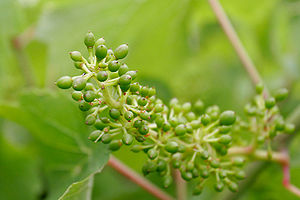
Yield (wine)
In viticulture, the yield is a measure of the amount of grapes or wine that is produced per unit surface of vineyard, and is therefore a type of crop yield...
. Not every flower on the vine gets fertilized, with the unfertilized flowers eventually falling off the vine. The percentage of fertilized flowers averages around 30 but can get as high as 60 or be much lower. Climate and the health of the vine play an important role with low humidity
Humidity
Humidity is a term for the amount of water vapor in the air, and can refer to any one of several measurements of humidity. Formally, humid air is not "moist air" but a mixture of water vapor and other constituents of air, and humidity is defined in terms of the water content of this mixture,...
, high temperatures and water stress having the potential of severely reducing the amount flowers that get fertilized. Coulure
Coulure
Coulure is a potential viticultural hazard that is the result of metabolic reactions to weather conditions that causes a failure of grapes to develop after flowering. In English the word shatter is sometimes used. Coulure is triggered by periods of cold, cloudy, rainy weather or very high...
occurs when there is an imbalance of carbohydrate levels in the vine tissues and some berries fail to set or simply fall off the bunch. Varieties like Grenache
Grenache
Grenache is one of the most widely planted red wine grape varieties in the world. It ripens late, so it needs hot, dry conditions such as those found in Spain, the south of France, and California's San Joaquin Valley. It is generally spicy, berry-flavored and soft on the palate with a relatively...
and Malbec
Malbec
Malbec is a purple grape variety used in making red wine. The grapes tend to have an inky dark color and robust tannins, and are long known as one of the six grapes allowed in the blend of red Bordeaux wine. The French plantations of Malbec are now found primarily in Cahors in the South West...
are prone to this abnormal fruit set. Millerandage
Millerandage
Millerandage or shot berries is a French term referring to an viticultural problem in which grape bunches contain berries of greatly different size and, most important, different levels of maturity. Its most common cause is too cold or otherwise bad weather during the flowering stage of the vines....
occurs when some fertilized flowers do not form seeds but only small berry clusters. Grape berry size depends on the number of seeds so berries with no seeds will be significantly smaller than berries containing seeds. On one cluster there may be berries of various sizes which can create problems during winemaking due to the varying "skin to pulp" ratio among the grapes. This can be caused by vine disease, such as fanleaf
Fanleaf
Fanleaf can mean:* Psathyrotes, a genus of North American desert plants* Fanleaf virus, a grape virus* Fioria, a genus of the family Malvaceae...
, or by a boron
Boron
Boron is the chemical element with atomic number 5 and the chemical symbol B. Boron is a metalloid. Because boron is not produced by stellar nucleosynthesis, it is a low-abundance element in both the solar system and the Earth's crust. However, boron is concentrated on Earth by the...
deficiency in the vine. Gewürztraminer
Gewürztraminer
Gewürztraminer is an aromatic wine grape variety that performs best in cooler climates. It is sometimes referred to colloquially as Gewürz, and in French it is written '...
and the Chardonnay clones
Clones
Clones is a small town in western County Monaghan, in the 'border area' of the Republic of Ireland. The area is part of the Border Region, earmarked for economic development by the Irish Government due to its currently below-average economic situation...
IA and Mendoza are both prone to millerandage.
Veraison
Following fruit set, the grape berries are green and hard to the touch. They have very little sugarSugar
Sugar is a class of edible crystalline carbohydrates, mainly sucrose, lactose, and fructose, characterized by a sweet flavor.Sucrose in its refined form primarily comes from sugar cane and sugar beet...
and are high in organic acids. They begin to grow to about half their final size when they enter the stage of veraison. This stage signals the beginning of the ripening process and normally takes places around 40-50 days after fruit set. In the Northern Hemisphere this will be around the end of July and into August and between the end of January into February for the Southern Hemisphere. During this stage the colors of the grape take form-red/black or yellow/green depending on the grape varieties. This color changing is due to the chlorophyll
Chlorophyll
Chlorophyll is a green pigment found in almost all plants, algae, and cyanobacteria. Its name is derived from the Greek words χλωρος, chloros and φύλλον, phyllon . Chlorophyll is an extremely important biomolecule, critical in photosynthesis, which allows plants to obtain energy from light...
in the berry skin being replaced by anthocyanins (red wine grapes) and carotenoids (white wine grapes). In a process known as engustment, the berries start to soften as they build up sugars. Within six days of the start of veraison, the berries begin to grow dramatically as they accumulate glucose
Glucose
Glucose is a simple sugar and an important carbohydrate in biology. Cells use it as the primary source of energy and a metabolic intermediate...
and fructose
Fructose
Fructose, or fruit sugar, is a simple monosaccharide found in many plants. It is one of the three dietary monosaccharides, along with glucose and galactose, that are absorbed directly into the bloodstream during digestion. Fructose was discovered by French chemist Augustin-Pierre Dubrunfaut in 1847...
and acids begin to fall.
The onset of veraison does not occur uniformly among all berries. Typically the berries and clusters that are most exposed to warmth, on the outer extents of the canopy
Canopy (vine)
In viticulture, the canopy of a grapevine includes the parts of the vine visible aboveground - the trunk, cordon, stems, leaves, flowers, and fruit. The canopy plays a key role in light energy capture via photosynthesis, water use as regulated by transpiration, and microclimate of ripening grapes...
, undergo veraison first with the berries and clusters closer to the trunk and under the canopy shade undergoing it last. There are some factors in the vineyards that can control the onset of veraison, limited water stress
Water stress
Researchers define water stress and water scarcity in different ways. For example, some have presented maps showing the physical existence of water in nature to show nations with lower or higher volumes of water available for use. Others have related water availability to population...
and canopy management that creates a high "fruit to leaf" ratio can encourage veraison. This is because the vine is biologically programmed to channel all its energies and resources into the berries, which houses its seedling offspring, so that they may have a better chance of survival. Conversely, very vigorous wines with lots of leaf shading for photosynthesis and water supply will delay the start of veraison due to the vines energies being directed towards continued shoot growth of new buds. For the production of high quality wine, it is considered ideal to have an earlier veraison. During this period the cane of the vine starts to ripen as well changing from green and springing to brown and hard. The vines begins to divert some of its energy production into its reserves in preparation for its next growth cycle.
After harvest
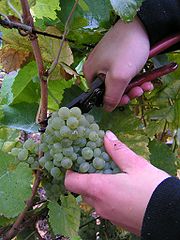
Harvest
Harvest is the process of gathering mature crops from the fields. Reaping is the cutting of grain or pulse for harvest, typically using a scythe, sickle, or reaper...
in which the grapes are removed from the vine and transported to the winery to begin the wine making process. In the Northern Hemisphere this is generally between September and October while in the Southern Hemisphere it is generally between February and April. The time of harvest depends on a variety of factors-most notably the subjective determination of ripeness
Ripeness
In United States law, ripeness refers to the readiness of a case for litigation; "a claim is not ripe for adjudication if it rests upon contingent future events that may not occur as anticipated, or indeed may not occur at all." For example, if a law of ambiguous quality has been enacted but never...
. As the grape ripens on the vines, sugars and pH
PH
In chemistry, pH is a measure of the acidity or basicity of an aqueous solution. Pure water is said to be neutral, with a pH close to 7.0 at . Solutions with a pH less than 7 are said to be acidic and solutions with a pH greater than 7 are basic or alkaline...
increase as acids (such as malic acid
Malic acid
Malic acid is an organic compound with the formula HO2CCH2CHOHCO2H. It is a dicarboxylic acid which is made by all living organisms, contributes to the pleasantly sour taste of fruits, and is used as a food additive. Malic acid has two stereoisomeric forms , though only the L-isomer exists...
) decrease. Tannins and other phenolic
Phenolic compounds in wine
The phenolic compounds - natural phenol and polyphenols - in wine include a large group of several hundred chemical compounds that affect the taste, color and mouthfeel of wine. These compounds include phenolic acids, stilbenes, flavonols, dihydroflavonols, anthocyanins, flavanol monomers and...
s also develop which can affect the flavors and aromas in the resulting wine. The threat of detrimental weather and vine diseases (such as grey rot) can also play a role in the time table. The balance of all these factors contributes to when a winemaker or vineyard manager decides that it is time to harvest.
Following the harvest, the vines continues the process of photosynthesis, creating carbohydrate reserves to store in the vine's roots and trunks. It will continue doing this until an appropriate level of reserves have been stored. At that point the chlorophyll in the leaves begin to break down and the leaves change color from green to yellow. Following the first frost the leaves begin to fall as the vine starts to enter its winter dormancy period. The following spring, the cycle begins again.
External Links
- Annual Cycle of the Grapevine and Stages of Grape Berry Development, information from Cooperative Extension

